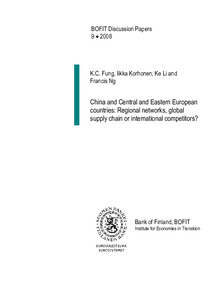China and Central and Eastern European countries : regional networks, global supply chain or international competitors?
Fung, K.C.; Korhonen, Iikka; Li, Ke; Ng, Francis (17.06.2008)
Numero
9/2008Julkaisija
Bank of Finland
2008
Julkaisun pysyvä osoite on
https://urn.fi/URN:NBN:fi:bof-201408071929Tiivistelmä
China has emerged as one of the world's leading recipients of foreign direct investment (FDI). Meanwhile, the successful transition experience of many Central and Eastern Euro-pean countries (CEECs) also enables them to attract an increasing share of global foreign investment, particularly from the European Union (EU). What is the relationship between inward FDI of China and the CEECs? We conceptualize the relationship according to three alternative paradigms: 1) China and the CEECs each exist in its own regional pro-duction network, with no linkage between FDI flows into China and into CEECs; 2) China and the CEECs together comprise a global production network, so that FDI into China is positively related to FDI into CEECs; and 3) FDI into China is a substitute for FDI into the CEECs, so that the correlation between them is negative. In this paper, we employ pan-el data to study this issue in detail. Specifically, we compare empirical estimates for 15 CEECs over the 15-year period 1990-2004 using four different econometric approaches: FGLS with Random effects, FGLS with fixed effects, EC2SLS and GMM. The result supports the conclusion that China's inward FDI does not crowd out CEECs' inward FDI. In fact, it shows that in some circumstances FDI flows in these two regions are moderately complementary. In addition, our analysis confirms the importance for FDI flows of recipient-country characteristics such as market size, degree of trade liberalization and labor quality, as well as a healthy global capital market. JEL classification numbers: F20, F21, F43 Keywords: Foreign Direct Investment (FDI), Regional Networks, Global Supply Chain, China's FDI, Central and Eastern European Countries' FDI
Julkaisuhuomautus
Published in Journal of Economic Integration, September 2009, v. 24, iss. 3, pp. 476–504
